

ANNOUNCEMENT
今天与大家分享评论家安德鲁·贝拉尔蒂尼(Andrew Berardini)为艺术家奈瑞·巴格勒米安(Nairy Baghramian)写的专题《倚靠我》,原刊于Mousse杂志第69刊,经编辑部授权后特此翻译发表。
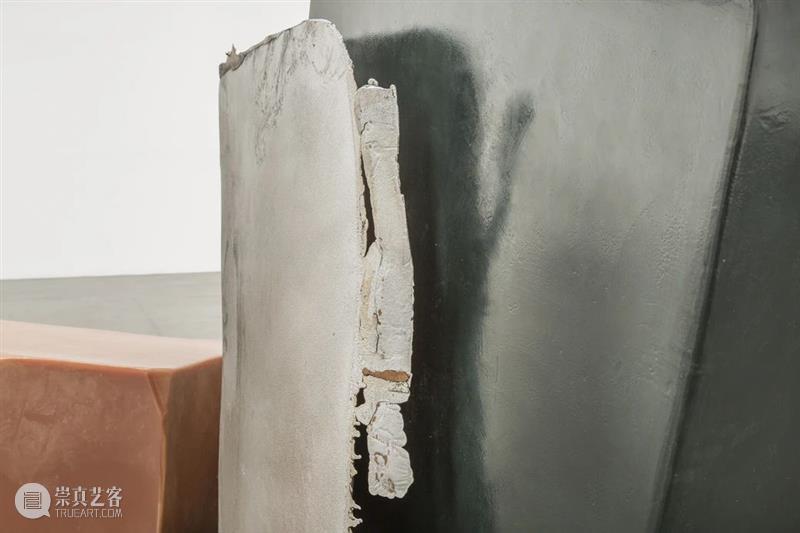
Maintainers A,kurimanzutto,2018年
倚靠我:奈瑞·巴格勒米安
安德鲁·贝拉尔蒂尼
奈瑞·巴格勒米安的雕塑作品形状奇异,常常看起来像是半成品,或者有些残破,被拐杖或支架支撑着,仿佛一群偷偷摸摸的无业游民,或者颓唐迷失的知识分子,彼此及各自的世界观之间相互牵掣,围坐论辩逃离的可能。这些作品以绝不流俗的幽默感和空间智慧组建起来,它们棱角嶙峋又肉欲丰满,蕴含生命又阒无生机,轻盈却又充满了空间存在感的厚重,有时又像是信手画出的随意草稿。我看着这些边界混沌、似乎来自异界的优美形状,感觉奈瑞·巴格勒米安的作品需要我们。
这些作品相互倚靠,倚靠着它们被放置于其中的建筑,倚靠着它们肇端而来的艺术源流,还倚靠着我们——它们的观众。起先我很担心这些雕塑(以及常与之相伴展出的照片)可能会在他们发起的智力游戏中太过孤芳自赏,但是当我看到“留级生”(Stay Downers)系列中的《逃课生》(Truant, 2016)那个肉嘟嘟的水蜜桃的扭曲形态下面,被放置得恰到好处的骨骼状拐杖时,突然觉得自己和这个雕塑可以做朋友,尽我们所能地彼此照应扶持。
我花了很多时间凝视它们,逐渐开始信任这些作品内在的怪异和肉身的悲怆。它们古怪的色彩、不时的渗出,还有它们松弛无力的魅力都表明,你不必非得掌握了笑点或者读过了正确的书籍才能喜欢它们。(有些艺术需要一个哲学博士学位才能理解;这些艺术通常不可见,是最最孤独的。)人们可以提出这样的论点:巴格勒米安技法高超地反思了现代主义,以及更直接的对象极简主义,为它们的形式上的策略注入更微妙的叙事(性别、材料、身体)和超出工业进步通常容忍范围的更多的脆弱。她的“作品全体”可以看作一具身体,它需要支架、拐杖和一点点支持,是在朋友们的些许帮助下才能存活的身体。
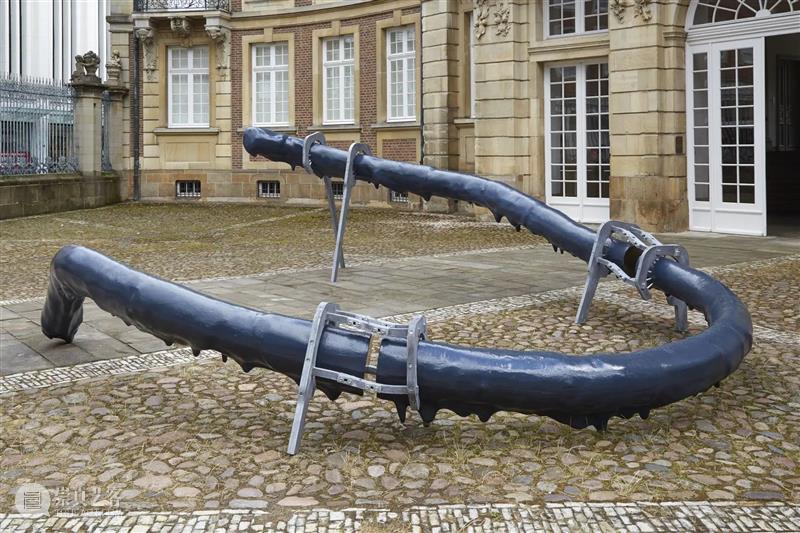
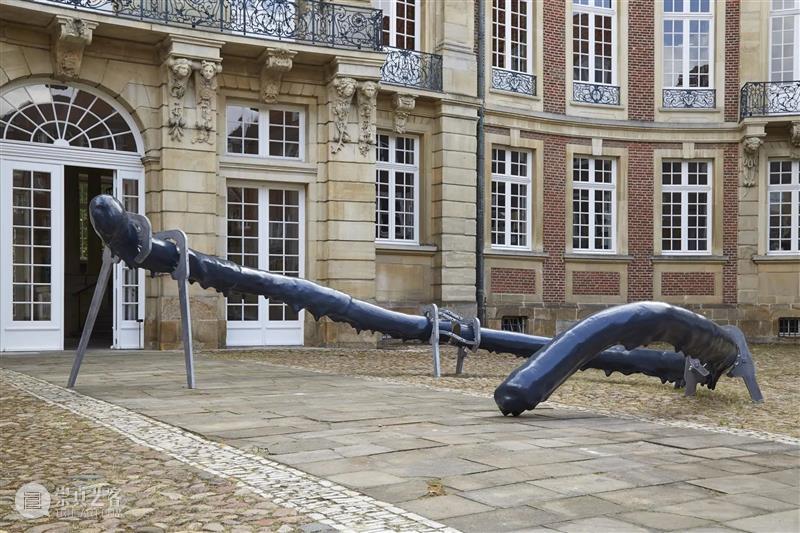
Beliebte Stellen / Privileged Points, 明斯特雕塑项目展
明斯特,2017
漆青铜,金属,绑扎链,张紧装置,橡胶
这些作品如此倚靠之时,它们的意义就层层体现出来,而故事给这些雕塑注入了生命。巴格勒米安受简·鲍尔斯的短篇小说《铁桌》(The Iron Table, 1950)的启发,在2002年创作了一件雕塑作品。故事里的一对顺性别异性恋夫妇,“盎格鲁-萨克逊人,”在一个穆斯林国家(也许是摩洛哥)的一间偏僻的酒店里,老调重弹着有关逃往沙漠、住在绿洲、远离腐朽堕落的西方文明和工业化影响的争论。这种争论显然对他们已经是家常便饭了,但在未来的某个“沉重悲痛”让他们闭上嘴巴、暂缓片刻之前,他们还是会一直争吵下去。小说开篇的段落描述了发生争吵的具体空间——一张铁桌子,放在一条宏伟崭新的绿荫大道与半空花坛旁边的一家酒店之间的水泥地上,酒店里住满了西班牙游客。“一条拉在木桩之间的绳线把酒店和绿荫道隔开了。”这种薄弱的分隔隐喻了分隔开了这对夫妇的、同样薄弱的争论,也隐喻了他们性别的差异,以及带着幻梦的游客与在观光目的地艰难劳作的人们之间的鸿沟。巴格勒米安的雕塑作品《铁桌(向简·鲍尔斯致敬)》(The Iron Table (Homage to Jane Bowles),2002)用现代雕塑材料的语言呈现了以上所有这些元素,唯一显眼的改动是把绳线换成了一串黑白相间的三角旗,像是法国雕塑家丹尼尔·布伦可能会用的那种。底部铺开的沙子可能代表了沙漠。每种形状看起来都很基础,也都具指涉性——圆锥体的结构,切成波浪状的喷漆木板(象征沙丘?)。如果它借取了极简主义的材料语言,那么它对这种语言的变换活用则是为了实现不同于极简主义的另一种目的。
作为巴格勒米安2016至2018年在欧美巡回展出的生涯回顾展览“专业偏见”(Déformation Professionnelle,法语术语,意指一个人在经过专业知识的训练之后反而让自己看问题的视野变得片面偏狭)的前奏,她为卡塞尔文献展创作了另一张桌子——《绘画桌(向简·鲍尔斯致敬)》(Drawing Table (Homage to Jane Bowles),2017)。这张桌子看起来经过了千锤百炼——它被直接丢在户外,任凭日晒风吹雨淋。时间和我们在它身上堆积起来的意义让这件雕塑疲惫不堪。这第二次致敬形貌沧桑,似乎仍未完工,一串三角旗破破烂烂、松松垮垮地挂在上面,只剩下白旗还连在绳子上。但我们来稍稍玩味一下其中的意义:当“铁桌”变成了“绘画桌”,也许所有那些钢铁的坚固分隔(比如铁幕)就已经转变了,而我们作为作者仍要继续承担的重负,依然是重塑世界的方式。分隔物于是成为了创作发生的场域,一种有关未来可能性的草图,而非对边界的反思。“我们得重新拿起绘图板……”(Back to the old drawing board…,美国习语,意指失败后从头开始。)而创作,这种召唤出一整个世界而化之为存在的行为,并不容易。我们继承着支离破碎的语言,不管是像这样的文字语言,还是雕塑的语言,我们都尽己所能将其变形活用成某些不一样的东西,最好是一些更好的东西。即便你没有读过鲍尔斯的小说,甚至哪怕不知道简·鲍尔斯是谁,这两件雕塑都有着截然不同的物理存在:第一件是一种形而上学的场面调度(mise-en-scène),第二件则是第一件疲倦、简陋的表弟。如果你想剥开外在,向更深处挖掘,表面之下确实还有更多的意义。可以说,巴格勒米安已经亮明了手上的牌,足够让我们看个一清二楚。我这样的作家能抓住一条线索,找到那个叙事,然后讲出我自己的故事。但太多时候,那些指涉,如果有的话,也并非完全清晰,而我们必须把这些元素、形状、色彩和材料拼完整,才能找到我们的意义。这些作品则足够慷慨,我们得以在其中找寻丰富的意涵。鲍尔斯只是创作的参考对象之一,许多视觉艺术家也短暂地客串登场了(即使他们并不总是致敬的对象)。
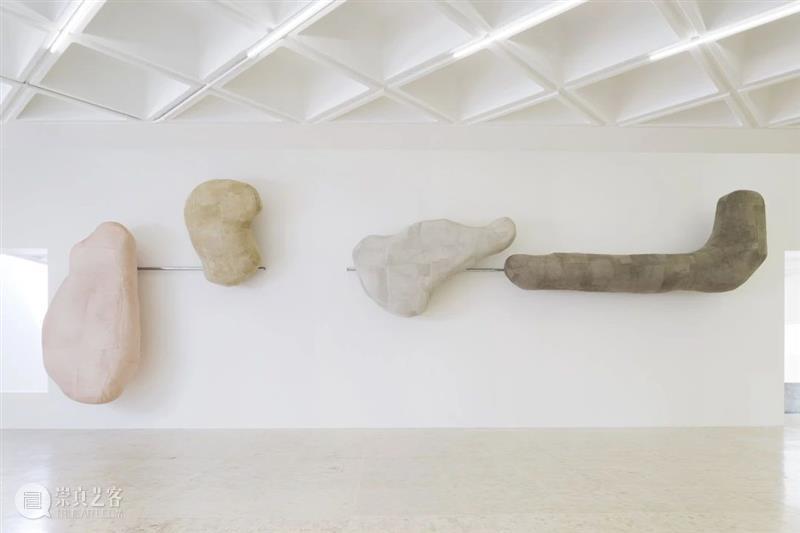
展览现场,“Nairy Baghramian - Hand me down"
墨西哥城塔马约当代美术馆,2015
如果我就这样眯着眼睛,盯着这些作品看的话,我能看得出来几位巴格勒米安过往所取径的艺术家们。在理查德·塞拉(Richard Serra)式的重型金属扭曲中,我看不到太多直接的影响,可能更多的是一种拒绝。2017年,巴格勒米安在德国明斯特雕塑计划展(Skulptur Projekte Münster)上安装了一件雕塑作品,展出地点正是20年前塞拉作品陈设的位置。塞拉的作品是一件两部分组成的钢塔,重达24吨,原本的创作意图是要反映它周边的巴洛克建筑。明斯特市民讨厌它。最终,顾不得它的场地特定性,那件作品被搬到了瑞士。虽然巴格勒米安为明斯特创作的作品也是个扭曲的重型金属体,但这条喷涂了底漆的青铜曲线卧倒在地,显然不像塞拉的那么气势汹汹,而更具流动感和一点有意为之的未完成感——它像是一只巨型蠕虫,身体柔软得可以骑上去,而不是一座压迫感逼人的监狱塔(对不起理查德·塞拉,我希望你不是故意的,但你的作品吓死我了)。如果这件雕塑不是在嘲弄可怜的理查德被大家讨厌的钢塔,那至少也是狡黠地对塞拉作品所遭受的意义抹除,更别提其负载的大男子主义眨了眨眼。如果我眯得再用力一些,更仔细观察的话,我能从巴格勒米安作品中好奇的情感诉求,以及它们对尺度与语境的思考玩味中,看到克莱斯·奥登伯格(Claes Oldenburg)早期的柔软雕塑(这些雕塑基本上要么是与他的第一任妻子帕蒂·慕夏(Patty Mucha)非正式地合作,要么是后来与第二任妻子库斯耶·范·布鲁根(Coosje van Bruggen)正式合作完成的)。巴格勒米安的作品在其场地中总是有意义的,并且这些作品需要彼此,需要空间,需要我们观众,来生成任何一种意义。她为塞拉维斯基金会(Serralves Foundation)创作的户外雕塑《冷肩膀》(Cold Shoulder,2014)位于葡萄牙波尔图,这件作品柔软的形状明显类似一块垫肩,并且参考了(至少我的脑海中和作品附带的新闻稿件里都这样觉得)奥登伯格和范·布鲁根创作的那些巨型日常物件——从掉落的冰淇淋甜筒到被丢弃的火柴盒,它们遍布世界各地的城市和雕塑园。作品的标题微妙地指向了女性的特殊经验,作为一个文字游戏,它可以被解读成多重含义,每种含义都很难轻易被确定下来。有时候,当我置身于巴格勒米安的装置作品中,似乎一眨眼的功夫就进入了伊夫·唐吉(Yves Tanguy)的画中,看着身旁那些梦幻而超现实的形状共同上演一场性感恶心交融合一的水下太空歌剧。2012年,她在温哥华现代艺术画廊(后来她又在回顾展“专业偏见”上反思性地重现了)一间狭长的展厅空间里摆满了细瘦的金属雕塑,长得好像麦克风支架,或者像是迷你版的亚历山大·考尔德(Alexander Calder)作品——不管像什么,总之是来自更棱角分明的异度现实平面。那场展览标题叫“班级重聚”(Class Reunion),所有的雕塑都以高中班上那些人物原型命名,比如“呆子”(Stiff)或者“阿飞”(Dandy)还有“馋嘴先生”(Mr. Hunger)。由于这些雕塑的摆放,移动穿行在展厅中超级尴尬。当然,在真实的班级聚会中周旋应酬也是无比尴尬的。这些金属雕塑太坚硬、太瘦弱,我一点都没有触碰他们的欲望,但他们还是有情感诉求的。我为他们感到难过,我也为自己感到难过:被迫穿行其中,忍受着这么多次尴尬的相遇,却没有看到一个拥抱。它们的形状让我稍稍笑了出来,一种同病相怜的笑。巴格勒米安能如此高超地通过这样布局抽象三维体,从中召唤出无比细微的人类情感(这里是通过作品标题和安排布置,但有时候也使用其他策略)。虽然明显不如唐吉的超现实生物那么黏腻感伤,但那些抽象的形体仍然散发着奇特的情感和个性。
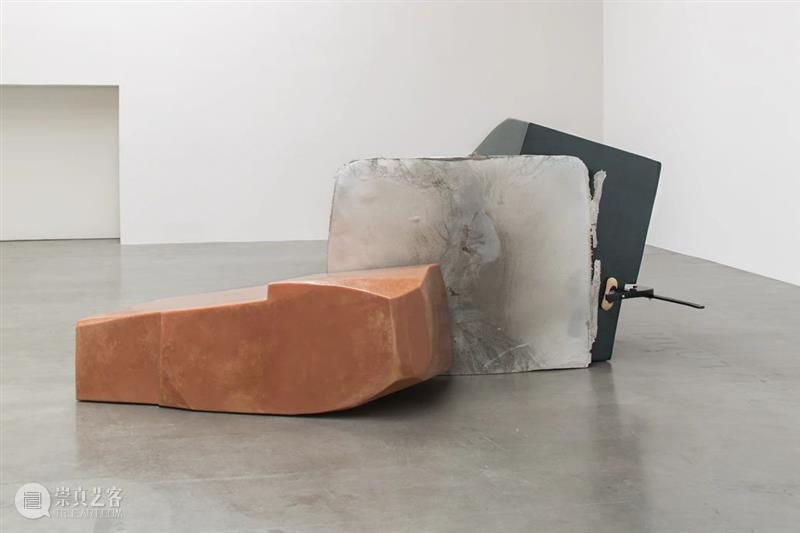
Maintainers A,kurimanzutto,2018年
铸铝,喷漆铝,软木,泡沫聚苯乙烯,石蜡
有时候巴格勒米安似乎是在开玩笑说,雕塑就像食物——意思是说,只要你有合适的原料和正确的菜谱说明,任何人都能做好。或者说,雕塑就像家具,这些小件的家居产品能跟随我们的身体变形,塑造我们的空间。某天她为了避雨钻进了一家书店(根据《卫报》2009年12月9日那一期斯凯·谢尔温的报道,这故事就是如此发生的),在那里知道了传奇的室内设计师珍妮特·拉维希耶(Janette Laverrière,生于1909年),随后即展开了与拉维希耶的合作。合作的成果于2008年在柏林双年展申克尔馆展出。拉维希耶的作品意蕴丰富,趣味十足,而且充满诗意,如同从扭曲的镜面中反射出来的形象一样,是巴格勒米安显然会欣赏的。
即使知道她能游刃自如地跨越各种不同的领域和材料,我也不禁会想,巴格勒米安的核心关怀是探讨,制作一件雕塑的意义究竟是什么,这是对身体和事物的基本思索。她在2011年柏林布赫兹画廊(Galerie Buchholz)的展览上浇筑出了大块硅胶板,最后的完成品太像肉了,让我起了一身鸡皮疙瘩。诸如“留级生”(2017年)系列中的那些仿生形态,不仅仅是占据空间的人工合成形态,而是以某种形式存活着,是有生命的。我们的身体永远是我们理解雕塑的标尺,但是巴格勒米安的雕塑——向我们、向它们所在的建筑、向彼此——倚靠过来。或许我们一直都在互相倚靠着,惟其如此才能生存下去。我们都被困在了一个彼此支持的结构中,这有点甜美,有点悲伤,总的来说很有意义。
译/叶晗
Lean on Me: Nairy Baghramian
by Andrew Berardini
Misshapen, often unfinished, or just a little broken, leaning on crutches or held up with braces, skulkingly unemployed or like lost intellectuals, hitched to each other and their worldviews, debating escape, Nairy Baghramian’s sculptures are held together with surprising humor and spatial intelligence. Angular and sensual, animal and inanimate, ethereal yet and freighted with gravitas of physical presence, sometimes they reflect back on themselves as loose, provisional sketches. In their inchoate and otherworldly shapeliness, I feel like the work of Nairy Bagramian needs us.
The works lean on one another, on the buildings they’ve been placed against, on the art they’ve evolved from, and on us—their audience. At first I worried that the sculptures (and the photographs that often accompany them) might be too insular in their intellectual games, but then I saw the bony crutch placed just so under the bent form of the fleshy peach Truant (2016) from the series Stay Downers, and decided that this sculpture and I could be friends, supporting each other as best we can.
Spending a lot of time looking at them, I grew to trust the works’ interior weirdness and corporeal pathos. Their quirky colors, occasional ooze, and limping charm suggest that you don’t necessarily need to be in on the joke or reading the right book to like them. (Some art requires a doctorate in philosophy to understand it; often invisible, those works are the loneliest of all). One could make the argument that Baghramian is deftly reflecting on modernism, and more squarely minimalism, imbuing their formal strategies with subtler narratives (gender, material, bodies) and greater frailty than industrial progress generally allows. Her “body of work” is a body that needs braces, crutches, a little support. It’s work that gets by with a little help from its friends.
The meanings manifest and layer as the pieces lean just so, and their stories shape these sculptures into creatures. Baghramian made a sculpture in 2002 inspired by Jane Bowles’s short story “The Iron Table” (1950). The story relays a conversation between a cis-hetero couple, “Anglo-Saxons,” in an out-of-the-way hotel in a Muslim country (probably Morocco) rehashing an argument about escaping into the desert to live in an oasis, far from the corrupting influence of Western civilization and industrialization. It is clearly a routine, this argument, but one they perform together until some “serious grief” in the future will silence them, a moment to be held off. They are arguing in a specific space described in the opening paragraph as an old iron table on cement between a grand new boulevard and a hotel filled with Spanish tourists next to a half-empty flowerbed. “A string stretched between stakes separated the hotel and the boulevard.” This flimsy separation is a metaphor for the equally flimsy argument that separates the couple, the difference in their genders, and the gap between the tourists with their fantasies and the people who work and struggle in the place the travelers are visiting. Baghramian’s sculpture The Iron Table (Homage to Jane Bowles) (2002) includes all these elements, drawing from the language of modern sculptural materials, with a flourish where that flimsy string becomes a string of black-and-white flags like Daniel Buren might use. The sand spread at its base is perhaps a reference to the desert. The various shapes look essential and referential—conical structures, painted wood cut into waves (dunes?). If it’s drawing from the material language of minimalism, it’s bending it to another purpose.
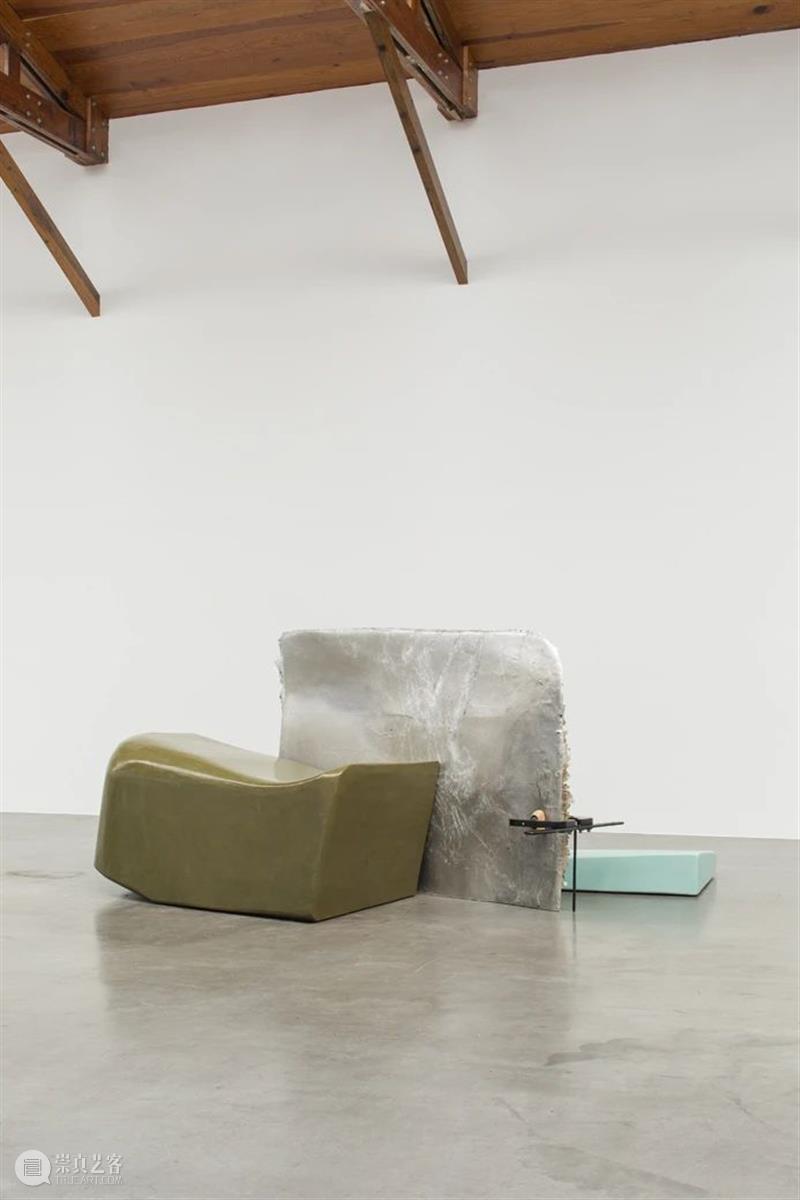
Maintainers A,kurimanzutto,2018年
铸铝,喷漆铝,软木,泡沫聚苯乙烯,石蜡
As a preamble to Baghramian’s career survey that toured Europe and the United States from 2016 to 2018, Déformation Professionnelle, she made another table for documenta called Drawing Table (Homage to Jane Bowles) (2017). This one looks hammered—a table left out in the sun, diminished by wind and rain. Time and the meaning we’ve heaped on it have wearied this sculpture. This second homage is battered, half-undone, its string of flags broken and loose from its tether, with only the black ones still clinging on. But just to play around with meaning for a flicker: when The Iron Table becomes a Drawing Table, perhaps the hard divide of all things iron (something like the Iron Curtain) has transformed and what we’re stuck with as authors is a way to remake the world. The divider then becomes a site for creation, a sketch for what’s possible rather than a reflection on boundaries. Back to the old drawing board… And creation, the act of summoning a world into being, ain’t easy. Stuck with the broken language we’ve inherited, whether it be text like this or the language of sculpture, we do what we can to bend it into something different and hopefully better. Even if you haven’t read Bowles’s story, or don’t even know who Jane Bowles is, these two sculptures have a distinct physical presence: the first a metaphysical mise-en-scène, the second its weary, sketchy cousin. And if you want to peel and dig even deeper, there are many atmospheres beneath the surface. Baghramian has tipped her hand, so to speak, enough for us to get a good look. A writer like me can grab that thread and find the story and tell my tale. But so often the references, if any, are not totally clear, and we have to put together the elements and shapes, colors and materials, to find our own meaning. And the works are generous enough to let us. Bowles is one point of reference, but many visual artists also make fleeting cameos (even if they’re not always the object of homage).
Squinting at the work just so, I can glimpse some of the past artists Baghramian has evolved through. In the heavy-metal curls of Richard Serra, I see not so much influence per se as perhaps a kind of rejection. In 2017 Baghramian installed a piece in the same site at Skulptur Projekte Münster as a Richard Serra from a previous edition. Serra’s work was a two-piece, twenty-four-ton welded steel tower meant to reflect the architecture of the Baroque building next to it. The people of Münster hated it. The sculpture was eventually moved to Switzerland in defiance of its intended site specificity. Though Baghramian’s piece for Münster is also a bit of curving heavy metal, the supine, primered bronze squiggle feels distinctly less menacing, a bit more mobile, and purposely unfinished—a giant worm soft enough to ride, rather than an oppressive prison tower (sorry Richard Serra, I hope you didn’t intend it, but that work of yours freaks me out). If the new piece is not a joke about poor Richard’s detested sculpture, her unfinished squiggle enacts at least a sly wink at the erasure of meaning that Serra’s work suffered, not to mention its freighted machismo. If I squint really hard at Baghramian’s works, I can see in their curious pathos and play with scale and context Claes Oldenburg’s early soft sculptures (often made as collaborations either unofficially with his first wife, Patty Mucha, or later officially with his second, Coosje van Bruggen). Baghramian’s work always makes sense in its site, and the works need each other, and the space, and us, the audience, to make any kind of sense. The soft shape of Cold Shoulder (2014), an outdoor sculpture made for the Serralves Foundation in Porto, Portugal, clearly resembles a shoulder pad, and references (to my mind and the accompanying press materials, at least) Oldenburg and van Bruggen’s gigantic common objects from dropped ice cream cones to abandoned matchbooks that litter cities and sculpture gardens across the world. Subtly turned toward the specific experience of women, the title is a play on words with a scattering of meanings, none too too easily pinned down. Sometimes when I’m inside an installation by Baghramian, I’m just for a blink inside an Yves Tanguy painting, with all those dreamy and sometimes difficult shapes composed into melty-sexy-gross underwater space operas. In 2012 in Vancouver at the Contemporary Art Gallery (and later did a kind of reprise reflection on in her retrospectival Déformation Professionnelle), she filled a long, narrowish room with metal sculptures resembling microphone stands, or mini Alexander Calders—in any case, creatures from a much more angular plane of alterreality. The show was called Class Reunion, and all the sculptures were named after high school archetypes, like Stiff and Dandy and Mr. Hunger. Moving around that room, thanks to their placement, was super awkward. Of course, circulating at actual class reunions is also super awkward. The metal sculptures were too hard and thin and wiry for me to be tempted to touch them, but they still had pathos. I felt bad for them and for me, forced to move through so many awkward encounters with nary a hug in sight. Their shapes made me laugh a little, sympathetically. Baghramian can expertly summon so much subtle human emotion from abstract three-dimensional objects when framed just so (here by their title and arrangement, but sometimes using other tactics). While distinctly less gooey than Tanguy’s surreal creatures, their abstraction still beam odd emotion and personality.
Sometimes Baghramian seems to joke that sculpture is like food—meaning, if you only have the right ingredients and instructions, anyone can do it well. Or that sculpture is like furniture, these smaller domestic things that bend to our bodies and shape our spaces. She learned about a brilliant interior designer, Janette Laverrière (b. 1909), in a bookshop one day while trying to stay out of the rain (so the story goes, anyway, according Skye Sherwin in the December 9, 2009 issue of The Guardian) and shortly thereafter began a collaboration that blossomed into an exhibition at the Schinkel Pavillon at the 2008 Berlin Biennale. Laverrière’s informed, playful, poetic work reflects back with its warped mirrors an image that Baghramian clearly admires.
Even knowing her ease in traipsing through diverse fields and materials, I can’t help feeling that Baghramian central concern is what it means to make a sculpture, an essential speculation about bodies and things. When she pours huge, gross slabs of silicone, as she did in her 2011 show at Galerie Buchholz, Berlin, the result was enough like flesh to make my skin crawl. Biomorphic forms like those in Stay Downers (2017) are not just spacy synthetic forms but somehow alive. Our bodies have always been the measure against which we understand sculpture, but Baghramian’s sculptures lean in—to us, to their buildings, to each other. Perhaps we’re all leaning on each other to survive all the time, caught in a support structure that’s sort of sweet and sort of sad and altogether meaningful.
关于作者和艺术家
安德鲁·贝拉尔蒂尼(Andrew Berardini)是作家,并担任Mousse杂志在洛杉矶的编辑。他最近共同策划了克里斯·莱姆萨鲁(Kris Lemsalu)在第58届威尼斯双年展(2019年)爱沙尼亚馆的个展。
奈瑞·巴格勒米安(Nairy Baghramian,1971年生于伊朗伊斯法罕,现生活和工作于柏林)探索继承于艺术史的形式与观念,以提出功能、装饰、抽象和女性主义的相关问题。她的雕塑作品——其原材料丰富多样,包括港铁、硅胶、树脂、皮革——将艺术史上的参照带入主体的领域:人体通过室内设计的政治被拆解重组。不稳定性是巴格勒米安作品中常常出现的主体,这一点在她使用各种脆弱的支撑物来支撑、展示她的作品中变得很明显:悬荡或倾斜,似乎总是处在崩塌边缘。巴格勒米安的主要展览包括:“特权点”(Privileged Points),卢森堡现代美术馆MUDAM,卢森堡(2019年);“奈瑞·巴格勒米安”,丽池公园水晶宫(Palacio de Cristal del Retiro),马德里(2018年);“专业偏见”(Déformation Professionnelle),沃克艺术中心(Walker Art Museum),明尼阿波利斯(2017-2018年);现代艺术博物馆(Museum der Moderne),萨尔茨堡(2017年);新当代艺术博物馆S.M.A.K. (Stedelijk Museum voor Actuele Kunst),根特(2016年);“后勃颈(附加物)”(Scruff of the Neck(Supplements)),装置艺术之家(Haus Konstruktiv),苏黎世,瑞士(2016年);“二手货”(Hand Me Down),塔马约当代美术馆(Museo Tamayo),墨西哥城(2015年)。她最近参与了第58届威尼斯双年展,“希望你生活在有趣时代”(May You Live in Interesting Times,2019年)。
About the writer and the artist
Andrew Berardini is a writer and Los Angeles editor for Mousse. He recently co-curated Kris Lemsalu’s solo presentation for the Estonian Pavilion at the 58th Venice Biennale (2019).
Nairy Baghramian (b. 1971, Isfahan, Iran; lives and works in Berlin) explores forms and concepts inherited from the history of art to address issues of functionality, decoration, abstraction, and feminism. Her sculptures— made from a wide range of materials including steel, silicon, resin, and leather—bring art historical references into the realm of the subjective: the human body is dismantled and recombined through the politics of interior design. Instability, a recurrent theme in Baghramian’s work, becomes evident in the use of tenuous and flimsy supports to hold and display her sculptures: dangling or leaning, always on the brink of collapse. Baghramian’s most important exhibitions include: Privileged Points, MUDAM, Luxembourg (2019); Nairy Baghramian, Palacio de Cristal del Retiro, Madrid (2018); Déformation Professionnelle, Walker Art Museum, Minneapolis (2017-2018); Museum der Moderne, Salzburg (2017); S.M.A.K. Stedelijk Museum voor Actuele Kunst, Ghent (2016); Scruff of the Neck (Supplements), Haus Konstruktiv, Zurich, Switzerland (2016); Hand Me Down, Museo Tamayo, Mexico City (2015). She has recently participated in the 58th Venice Biennale, May You Live in Interesting Times (2019).
有关kurimanzutto的更多信息,请访问我们的网站kurimanzutto.com,持续关注我们的微信公众号,并在各种社交媒体通过@kurimanzutto和#kurimanzutto与我们互动!
For more information on kurimanzutto, please visit us at kurimanzutto.com, and connect with us on social media via @kurimanzutto and #kurimanzutto.
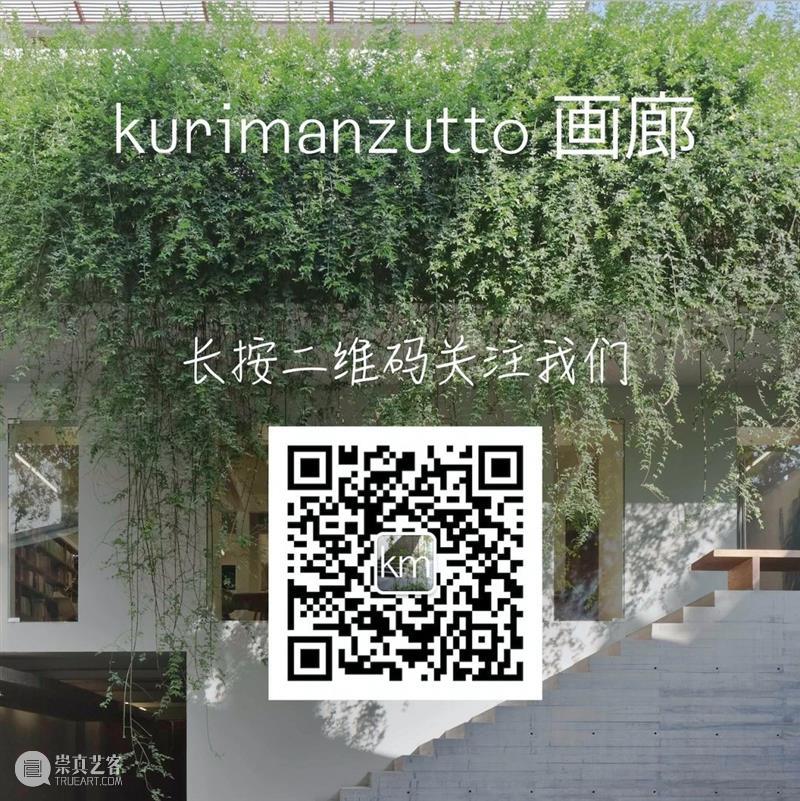


已展示全部
更多功能等你开启...





 分享
分享